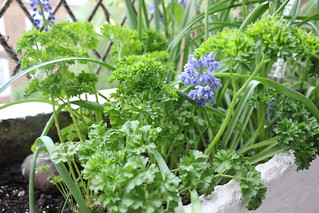It's been the same story with parsley, thyme and chives - in fact every bought herb! But no more. I have a built in windowbox on my balcony, just 9 inches depth and width (front to back) with a length of 70 inches. At the beginning of winter, I transplanted some shop bought parsley into the windowbox thinking this might lengthen its useful life by a week or so. It's still flourishing. Several weeks ago, I did the same with a pot of coriander. Same story. In fact, both have grown and are looking very lush.
So, whether you want to avoid the wait for home-sown herbs or simply to extend the life of your shop-bought herbs, here's how to do it.
As soon as you bring pots of supermarket herbs home, take off the cellophane wrapper, give them a good watering if the soil feels dry and prepare a hole in your planter, terracotta pot or window box.
If you're starting a planter from scratch, use multi-purpose compost - and, if you have any, add several handfuls of perlite or grit added for drainage.
The hole should be at least a third larger than the pot the herb came in. A tiny sprinkling of bonemeal well mixed into the soil at the bottom of the hole will help the roots to establish in their new home. (Don't worry if you don't have any.)
Take the herb out of its pot, carefully tease out one or two roots if necessary, and place in the hole. Put the soil back all around the plant, gently firming it in and making sure that the plant is sitting at the same soil level as it was in its pot. Gently water the soil all around the plant to settle the soil around the roots - and don't forget to keep the soil moist (but not wet) by checking daily to see if more water is needed. (Do this by pushing a finger about 2 cm into the soil; if the soil feels dry, the plant will need watering.)
If you're starting a planter from scratch, use multi-purpose compost - and, if you have any, add several handfuls of perlite or grit added for drainage.
The hole should be at least a third larger than the pot the herb came in. A tiny sprinkling of bonemeal well mixed into the soil at the bottom of the hole will help the roots to establish in their new home. (Don't worry if you don't have any.)
Take the herb out of its pot, carefully tease out one or two roots if necessary, and place in the hole. Put the soil back all around the plant, gently firming it in and making sure that the plant is sitting at the same soil level as it was in its pot. Gently water the soil all around the plant to settle the soil around the roots - and don't forget to keep the soil moist (but not wet) by checking daily to see if more water is needed. (Do this by pushing a finger about 2 cm into the soil; if the soil feels dry, the plant will need watering.)
Herbs produced for supermarkets are intensively grown with too many plants in the pot to survive beyond the seedling stage. There simply isn't enough space or nutrients in the pot for the herb to grow well. By transplanting into a bigger space, the roots can seek out more nutrients and the plant not only survives but thrives!
*Coriander, parsley and chives respond well to having the occasional stem snipped off and will reshoot (but not forever), especially if the soil around them is kept moist (but not soaking!). Coriander doesn't normally reshoot, so I imagine that this is because, as the plant is trimmed, smaller seedlings have access to light and air and so grow. Whatever the reason, it works - and it's so great to have fresh herbs on hand!
.............







